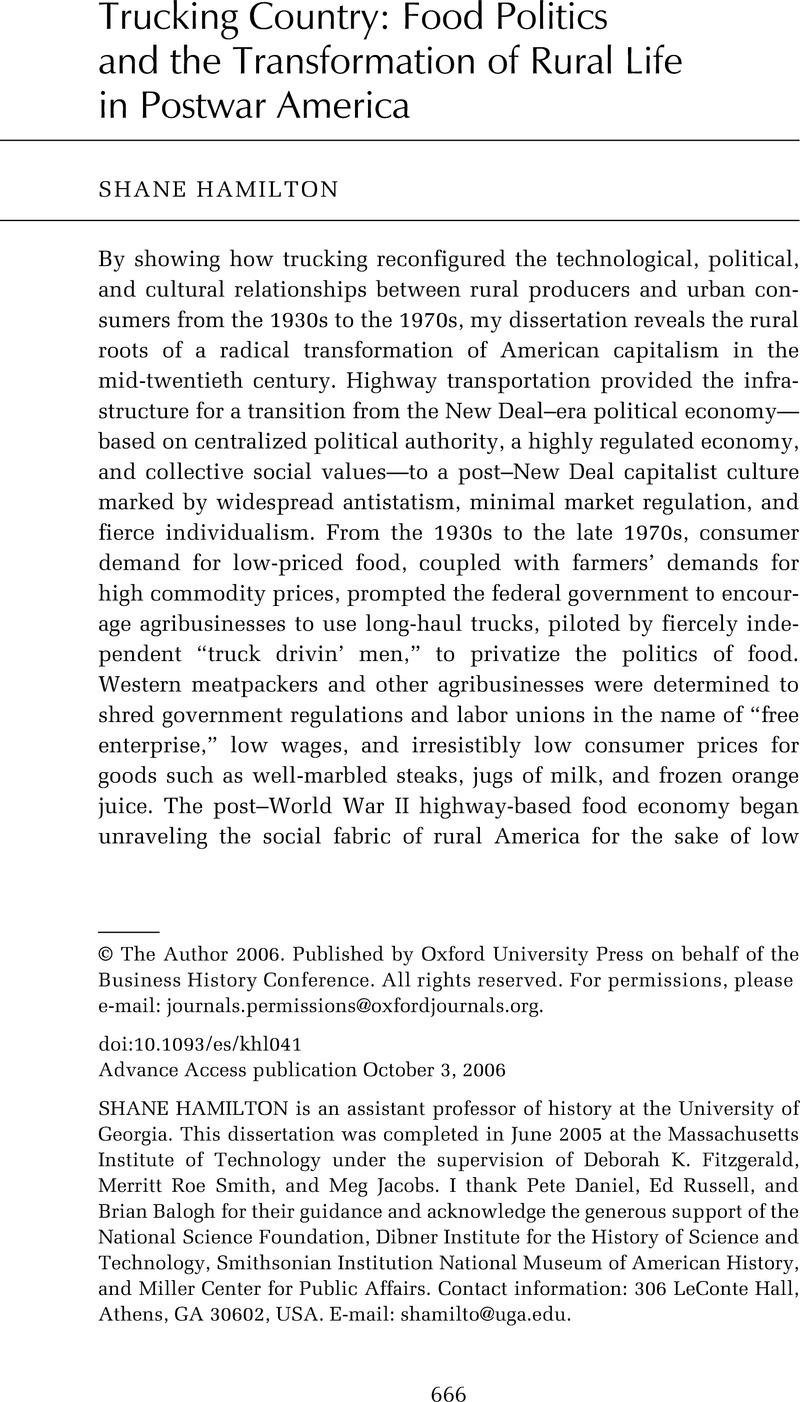Article contents
Trucking Country: Food Politics and the Transformation of Rural Life in Postwar America
Published online by Cambridge University Press: 18 February 2015
Abstract

- Type
- Dissertation Summaries
- Information
- Copyright
- Copyright © The Author(s) 2006. Published by Cambridge University Press on behalf of the Business History Conference. All rights reserved.
References
1. On Wal-Mart, see Lichtenstein, Nelson, ed., Wal-Mart: The Face of Twenty-First-Century Capitalism (New York, 2006)Google Scholar.
2. Cronon, William, Nature’s Metropolis: Chicago and the Great West (New York, 1991)Google Scholar; Strom, Claire, Profiting from the Plains: The Great Northern Railway and Corporate Development of the American West (Seattle, 2003)Google Scholar.
3. Martin, Albro, Railroads Triumphant: The Growth, Rejection, and Rebirth of a Vital American Force (New York, 1992)Google Scholar; Goddard, Stephen, Getting There: The Epic Struggle between Road and Rail in the American Century (Chicago, 1994)Google Scholar. Certainly, regulation discouraged technological innovation in the railroad industry—which may or may not have made railroads more competitive with trucks; see Usselman, Steven W., Regulating Railroad Innovation: Business, Technology, and Politics in America, 1840–1920 (New York, 2002)Google Scholar.
4. Robyn, Dorothy, Braking the Special Interests: Trucking Deregulation and the Politics of Policy Reform (Chicago, 1987)Google Scholar; Rothenberg, Lawrence S., Regulation, Organizations, and Politics: Motor Freight Policy at the Interstate Commerce Commission (Ann Arbor, Mich., 1994)CrossRefGoogle Scholar.
5. Work on the intersections of technology, agriculture, and rural life that I found particularly helpful includes Fitzgerald, Deborah K., Every Farm a Factory: The Industrial Ideal in American Agriculture (New Haven, Conn., 2003)Google Scholar; Barron, Hal S., Mixed Harvest: The Second Great Transformation in the Rural North, 1870–1930 (Chapel Hill, N.C., 1997)Google Scholar; Adams, Jane, The Transformation of Rural Life: Southern Illinois, 1890–1990 (Chapel Hill, N.C., 1994)Google Scholar; Danbom, David B., The Resisted Revolution: Urban America and the Industrialization of Agriculture, 1900–1930 (Ames, Iowa, 1979)Google Scholar; Daniel, Pete, Breaking the Land: The Transformation of Cotton, Tobacco, and Rice Cultures since 1880 (Urbana, Ill., 1985)Google Scholar; Stoll, Steven, The Fruits of Natural Advantage: Making the Industrial Countryside in California (Berkeley, Calif., 1998)Google Scholar; Worster, Donald, Dust Bowl: The Southern Plains in the 1930s (New York, 1979)Google Scholar.
6. Sperling, Celia, The Agricultural Exemption in Interstate Trucking: A Legis-lative and Judicial History (Washington, D.C., 1957)Google Scholar.
7. The politics behind the establishment of these regulations has been superbly studied by Childs, William R. in Trucking and the Public Interest: The Emergence of Federal Regulation, 1914–1940 (Knoxville, Tenn., 1985)Google Scholar. A forthcoming book by Mark H. Rose, Bruce E. Seely, and Paul Barrett (Transportation and Public Policy in Twentieth-Century America) puts the regulation and deregulation of trucking within a broader policy perspective.
8. Wyckoff, D. Daryl, Truck Drivers in America (Lexington, Mass., 1979), 4Google Scholar; Perry, Charles R., Deregulation and the Decline of the Unionized Trucking Industry (Philadelphia, 1986), 62Google Scholar. However, as Daryl Wyckoff, D. and Maister, David H. pointed out in their 1975 survey of owner-operators (The Owner-Operator: Independent Trucker [Lexington, Mass., 1975], 8–12)Google Scholar, the ICC tended to undercount owner-operators, often ignoring haulers of exempt agricultural commodities; this would make the percentage of unionized owner-operators significantly less than 20%.
9. Keeshin, John Lewis, No Fears, Hidden Tears: A Memoir of Four Score Years (Chicago, 1983), 20Google Scholar. On Keeshin’s role in formulating early trucking regulation, see Childs, , Trucking and the Public Interest, 101–18Google Scholar. On highway construction, see Seely, Bruce E., Building the American Highway System: Engineers as Policy Makers (Philadelphia, 1987)Google Scholar; Rose, Mark H., Interstate: Express Highway Politics, 1939–1989, 2d ed. (Knoxville, Tenn., 1990)Google Scholar.
10. On the corporate consolidation of regulated trucking in the mid-twentieth century, see Thomas, James Harold, The Long Haul: Truckers, Truck Stops, and Trucking (Memphis, Tenn., 1979).Google Scholar
11. Jacobs, Meg, Pocketbook Politics: Economic Citizenship in Twentieth-Century America (Princeton, N.J., 2005)Google Scholar.
12. Cronon, Nature’s Metropolis; Walsh, Margaret, The Rise of the Midwestern Meat Packing Industry (Lexington, Ky., 1982)Google Scholar; Yeager, Mary, Competition and Regulation: The Development of Oligopoly in the Meat Packing Industry (Greenwich, Conn., 1981)Google Scholar; Horowitz, Roger, Negro and White, Unite and Fight!: A Social History of Industrial Unionism in Meatpacking, 1930–90 (Urbana, Ill., 1997)Google Scholar.
13. Fink, Deborah, Cutting into the Meatpacking Line: Workers and Change in the Rural Midwest (Chapel Hill, N.C., 1998)Google Scholar; Stull, Donald D., Broadway, Michael J., and Griffith, David, eds., Any Way You Cut It: Meatprocessing and Small-Town America (Lawrence, Kans., 1995)Google Scholar.
14. DuPuis, E. Melanie, Nature’s Perfect Food: How Milk Became America’s Drink (New York, 2002)Google Scholar; Block, Daniel R., “The Development of Regional Institutions in Agriculture: The Chicago Milk Marketing Order” (Ph.D. diss., University of California–Los Angeles, 1997)Google Scholar.
15. “Who We Are, Why We Are, Where We Are,” Overdrive, Feb. 1962, p. 25.
16. “Truckin’ with Overdrive,” Time, 1 Sep. 1975, p. 56.
17. Lyons, Richard D., “Truckers’ Anger Born of Threats to Their Self-Reliant Way of Life,” New York Times, 24 June 1979, p. 16.Google Scholar
18. Barton, Timothy D., “Small Truckers’ Life: Hard, Getting Harder,” New York Times, 11 Feb. 1983, p. 27.Google Scholar
19. Engel, Cynthia, “Competition Drives the Trucking Industry,” Monthly Labor Review 121 (April 1998): 34–41Google Scholar; Belzer, Michael H., Sweatshops on Wheels: Winners and Losers in Trucking Deregulation (New York, 2000)Google Scholar.
- 1
- Cited by




